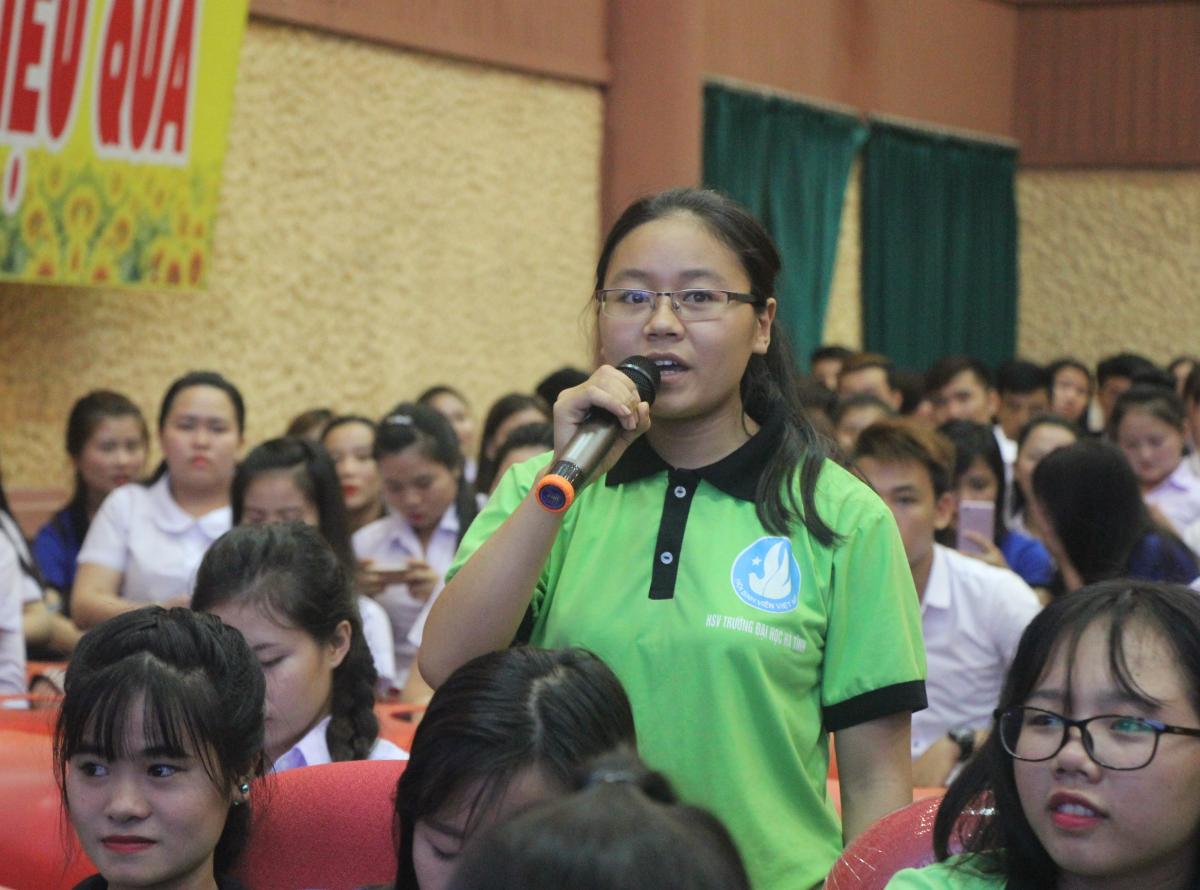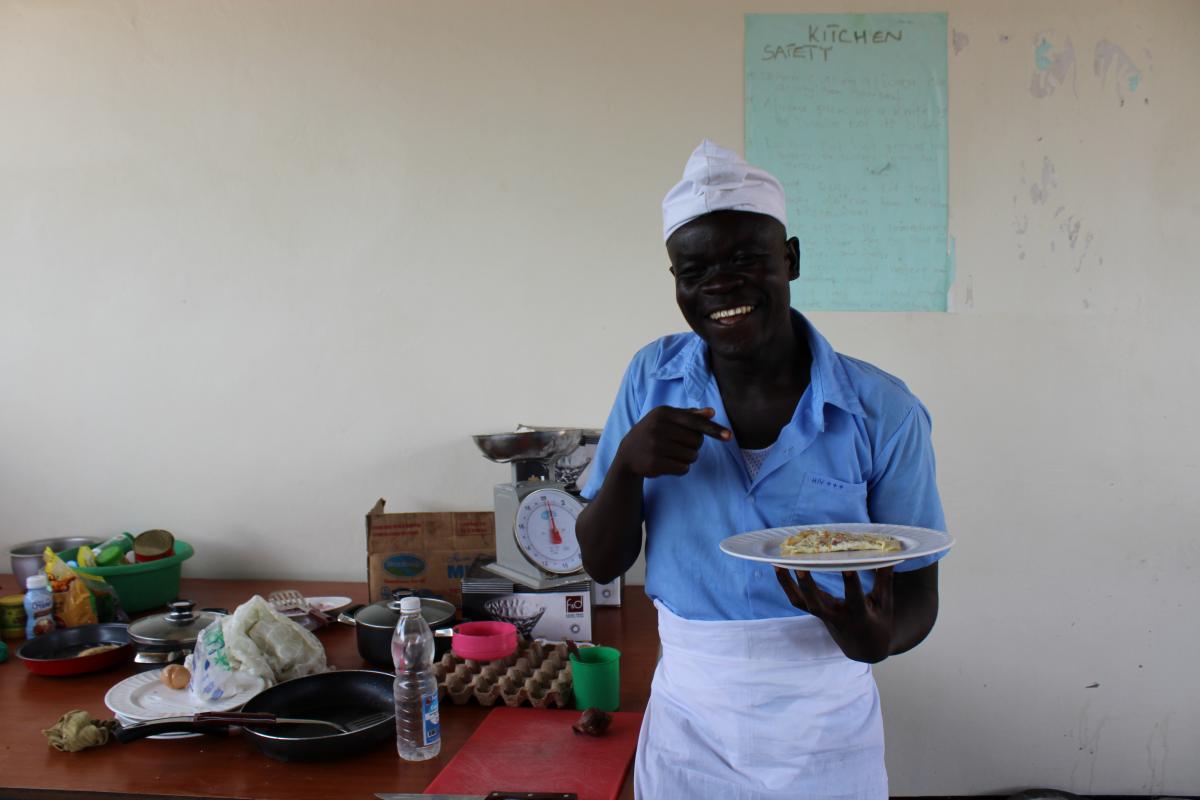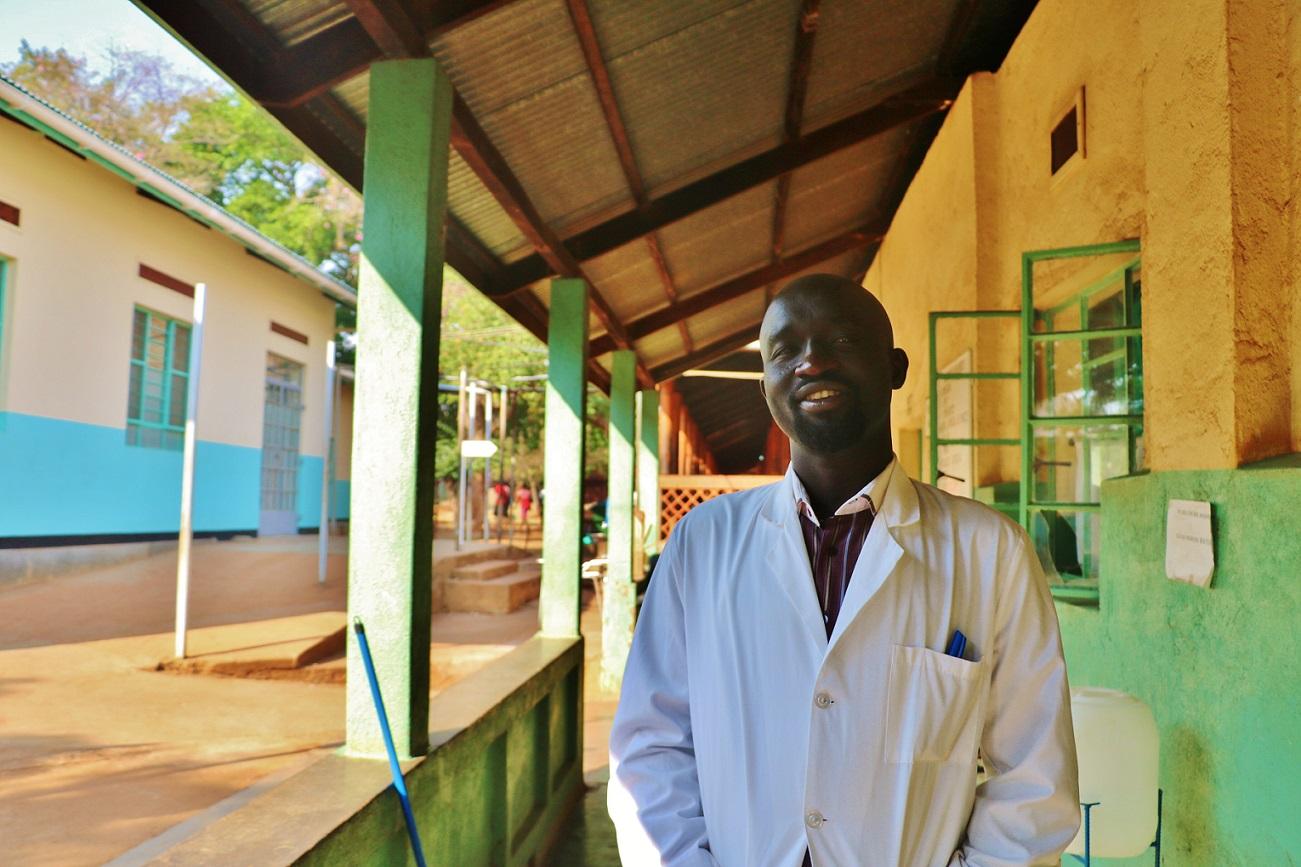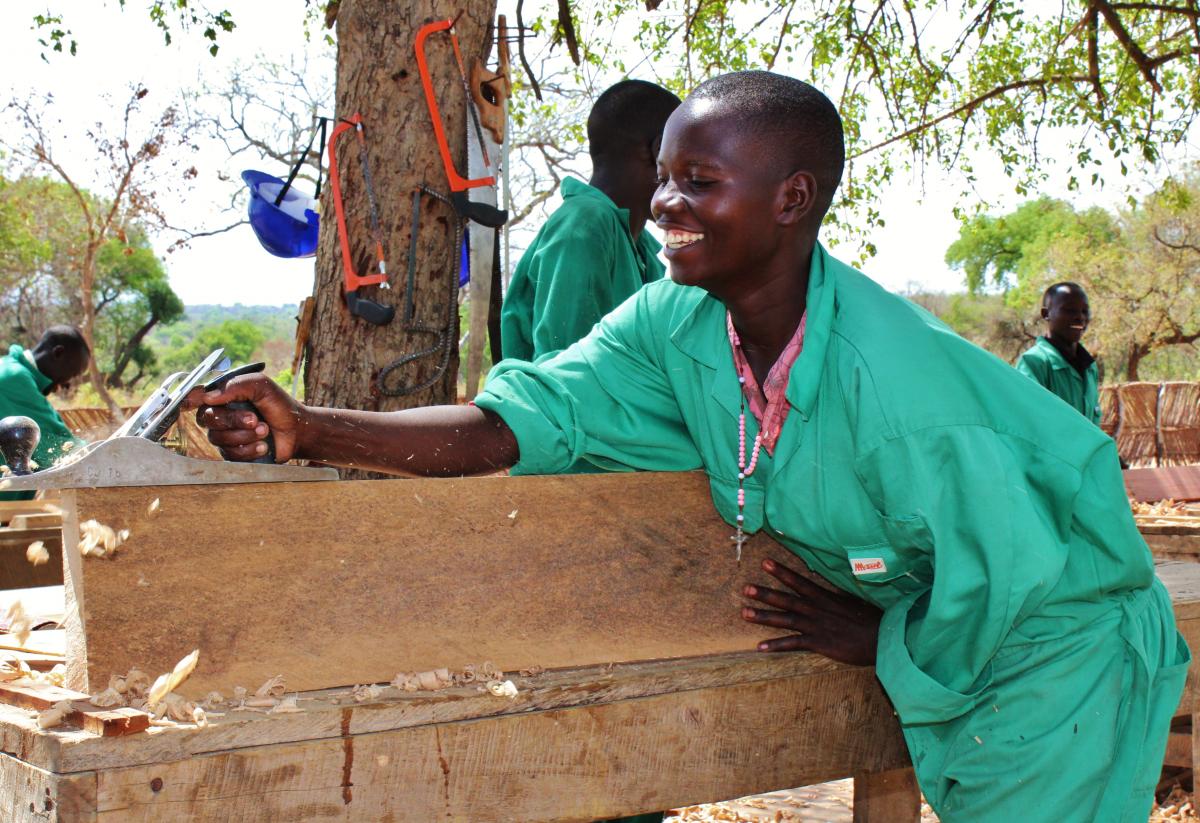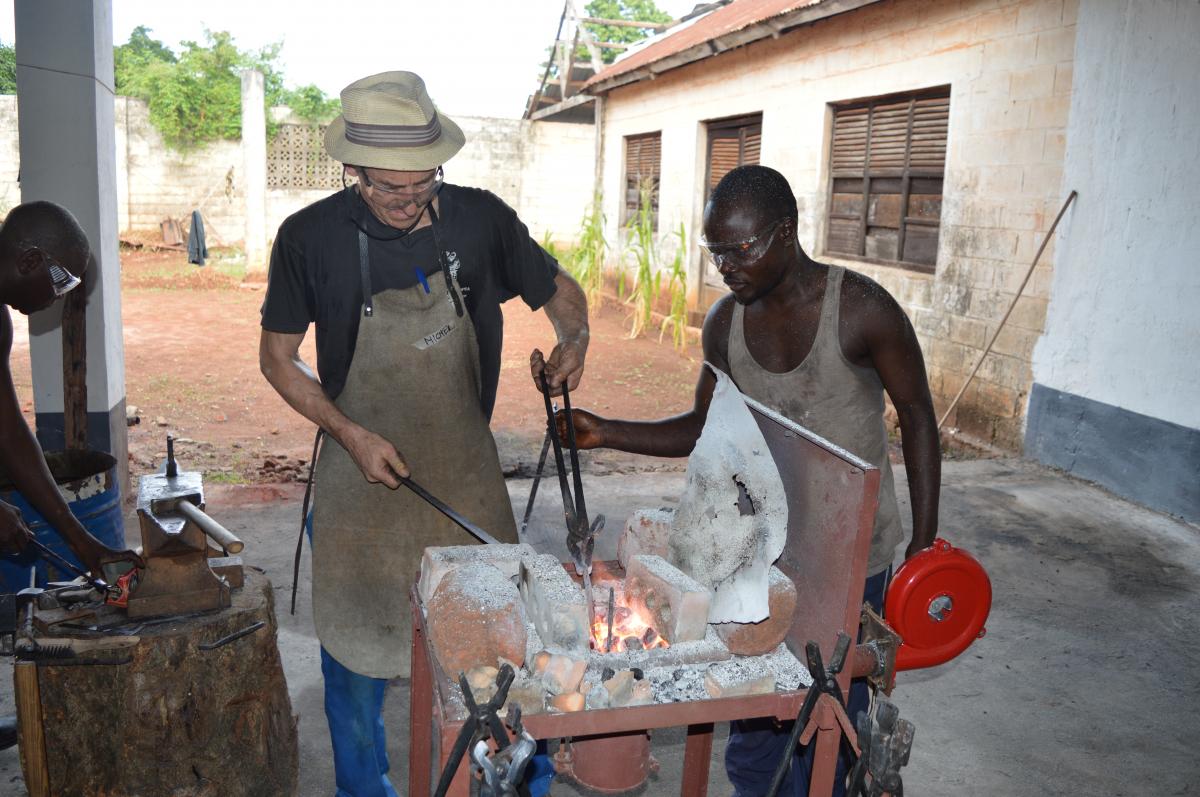Search
Viewing 2175 to 2190 of 2520 news
-
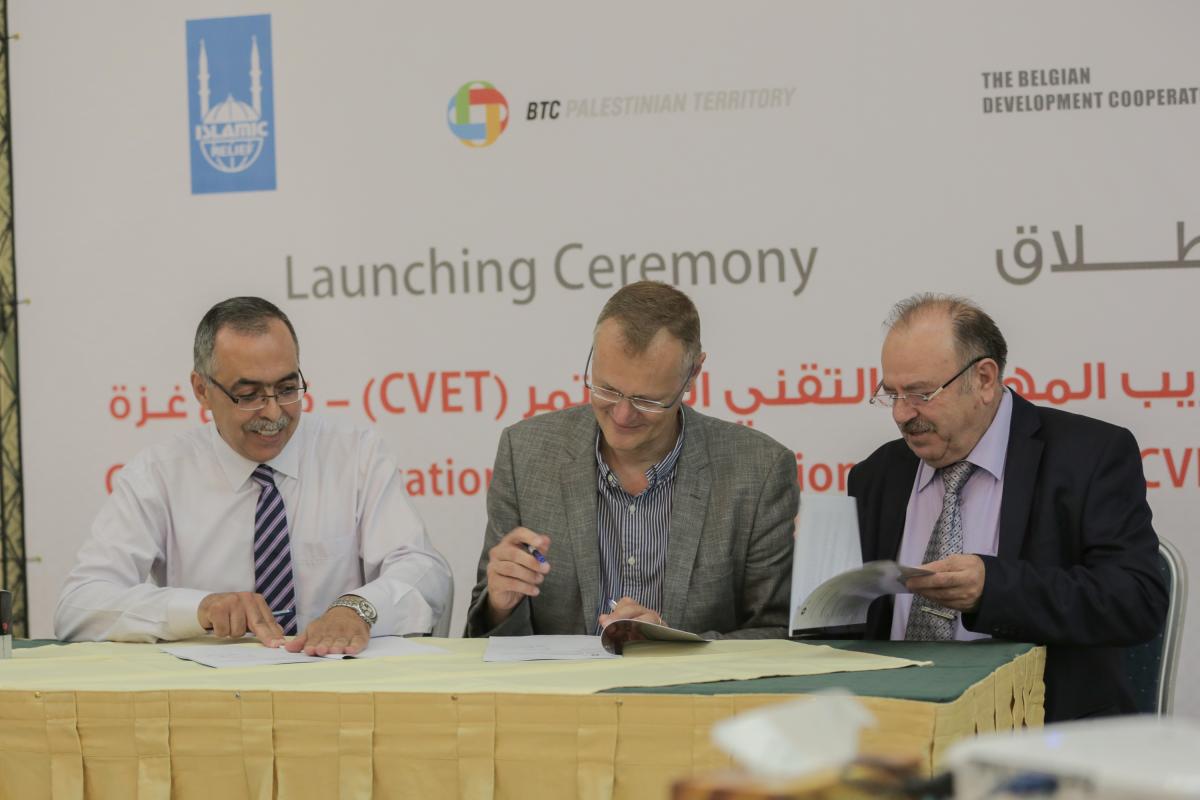
Launch of the Continuous Vocational and Educational Training (CVET) program in Gaza
Laura SCHILLEMANS | 10/07/2017
On the 5th of July, the Continuous Vocational and Educational Training (CVET) program was launched under the attendance of Mr. Dirk Deprez (Representative of the Belgian Development Agency), Mr. Muneeb Abu Ghazaleh (Country Director of IRPAL), Mr. Saeed Jad Al Haq (Director of Vocational and Technical Department of MoEHE), Mr. Mohammed Abu Hayya (General Director of the Vocational Training Department at the Ministry of Labor) and Dr. Maher Al Tabba (Chamber of Commerce).CVET can be defined as: “Education or training after initial education or entry into working life, aimed at helping individuals to improve or update their knowledge and/or skills; acquire new skills for a career move or retraining; continue their personal or professional development”[1].The organization of CVET courses can be considered as one of the effective instruments that contribute to the implementation of the National TVET Strategy (2010) in the Palestinian Territory.The explicit objective of CVET is to strengthen the competitiveness of the private sector by enabling skills upscaling and skills upgrading of its (future) staff. For obvious reasons, this will also contribute to the efforts of decreasing youth unemployment in the Palestinian Territory and foster sustainable economic growth.A total number of 32 CVET initiatives were successfully introduced by 30 TVET institutions in partnership with private sector companies of which 12 institutions are situated in Gaza and 18 institutions in West Bank:7 Technical Colleges, of which 4 in West Bank and 3 in Gaza 10 Vocational Secondary Schools, of which 7 in West Bank and 3 in Gaza 13 Vocational Training Centres, of which 7 in West Bank and 6 in Gaza A total number of around 350 students (employees and job seekers) are expected to benefit from the CVET fund. The total budget for the CVET initiatives amount to 171,500 euros of which 102,000 euros in the West Bank and 69,500 euros in Gaza. IRPAL contributes with the amount of 15,000 euros. The period of the initiatives varies between a minimum of 60 hours and a maximum of 120 hours of training over a 2 to 6 months period. The decision of the ECIB program of the Belgian Development Cooperation to start with a CVET pilot is based on a clearly expressed need to the private sector for more specialized and better-trained personnel during the TVET week, Career days and other events and meetings.This CVET pilot of the ECIB is only a first step towards a more comprehensive support program of the Belgian Development Cooperation for the private sector in the Palestinian Territory. A more comprehensive support program will have the great benefit of being able to tackle the different challenges that the private sector faces in a coordinated way.[1] See the terminology of the European education and training policy, Cedefop, 2008
-
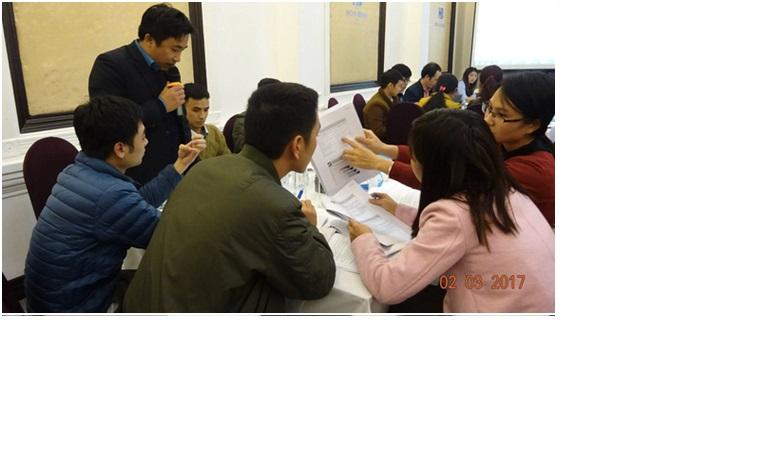
Roll out training on the new Planning and Investment Law
Huong TRANTHANH | 10/07/2017
The Vietnam Ministry of Planning and Investment (MPI) has extended its training cycle on the new Planning and Investment Law and monitoring and evaluation of Social Economic Development Plan (SEDP) towards another set of provinces and local governments. Topics treated are: Annual and Medium-term public investment planning, appraisal and decision-making on investment within a set government policy framework. The least developed provinces were targeted and about 900 officials participated. In an effort to transfer knowledge more efficiently to local governments, a first cycle of Training of Trainers has been organized on the topic, with participants of 10 provinces. These trainings are expected to have a clear impact on quality of planning and implementation of investments, thus contribute to social and economical development. CDPR is in a phase of accelerated implementation, inspired by the drive of the Vietnamese Government to implement better planning practices as the soonest. This also means that disbursements and project implementation is well ahead of schedule. CDPR is in its final phase and is expected to end at the latest by end 2018. Capacity Development for Planning Reform (CDPR) is the last remaining project of its kind in supporting the Ministry of Planning and Investment. Its main objective is to strengthen the Vietnamese government capacity at central and local level to improve efficiency of planning and public investment as to foster strong and equitable social progress and economic development. CDPR has supported MPI with expertise to make a new Public Investment Law. Subsequently, CDPR is supporting MPI in the dissemination of the law and its application at local level nationwide.
-
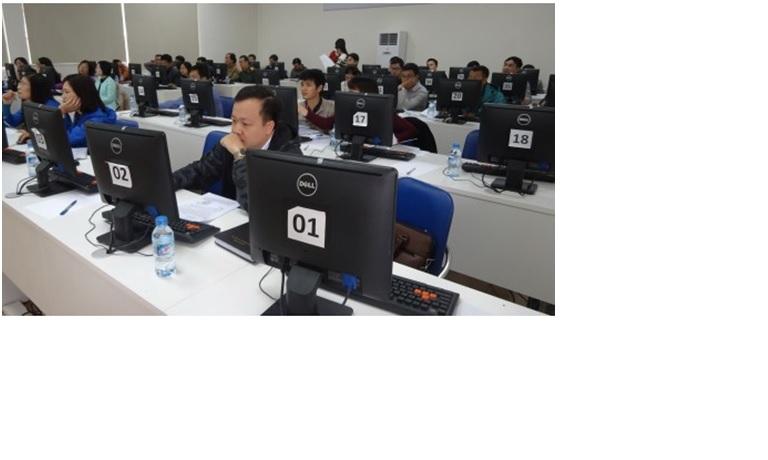
600 officials trained on the automated Project Cycle Management System for public investment
Huong TRANTHANH | 10/07/2017
The Vietnamese Government is rapidly modernizing its administration. Since 1977, a paper-based system was used to plan, implement and monitor all public investment nationwide. This has become a very inefficient and time-consuming method prone to errors. CDPR has supported this effort by organizing trainings to introduce the database and the automated Project Cycle Management System (PCM) for public Investment to decentralized Local governments. The new system has all features of modern management software: electronic signature for decision-making, new adapted formats for reporting and updating planning. By July 2017, 600 officials of 38 local governments throughout the country have been trained so far. It is expected that the use of the IT system will improve efficiency of administration, smoother implementation of projects, tighter cost control and better development results. Capacity Development for Planning Reform (CDPR) is the last remaining project of the Belgian government in support to the Ministry of Planning and Investment (MPI). Its main objective is to strengthen the Vietnamese government capacity at central and at local level to improve efficiency of planning and public investment as to foster strong and equitable social progress and economic development. Enhanced use of IT tools in combination with the introduction of a new Public Investment Law will certainly have a palpable impact on social and economic progress. CDPR is in its final phase and is expected to end by end 2018.
-
Students of Ha Tinh University participated in the forum “Climate Change and responsibilities of the youth”
Huong TRANTHANH | 10/07/2017
After one month call, the photo contest “Climate change and responsibility of the youth” received more than 100 photos from students of Ha Tinh University. 10 best ones were chosen for awards. The award ceremony was held on 8th June 2017 in Ha Tinh city, as part of the Forum “Climate Change and responsibilities of the youth!” The event was co-organized by the Project Coordination Unit of SRDP – IWMC Ha Tinh in cooperation with Ha Tinh University, as part of the project's awareness raising and community development activities. More than 300 students of Ha Tinh University participated in this forum and shared their thoughts with experts in Climate changes (CC) on various topics including the reasons for CC, what the students can do to contribute to the city's resilient efforts towards CC. The project also works with selected departments of the university, so that students of the final year can get support to implement their final projects with regard to CC issues.
-
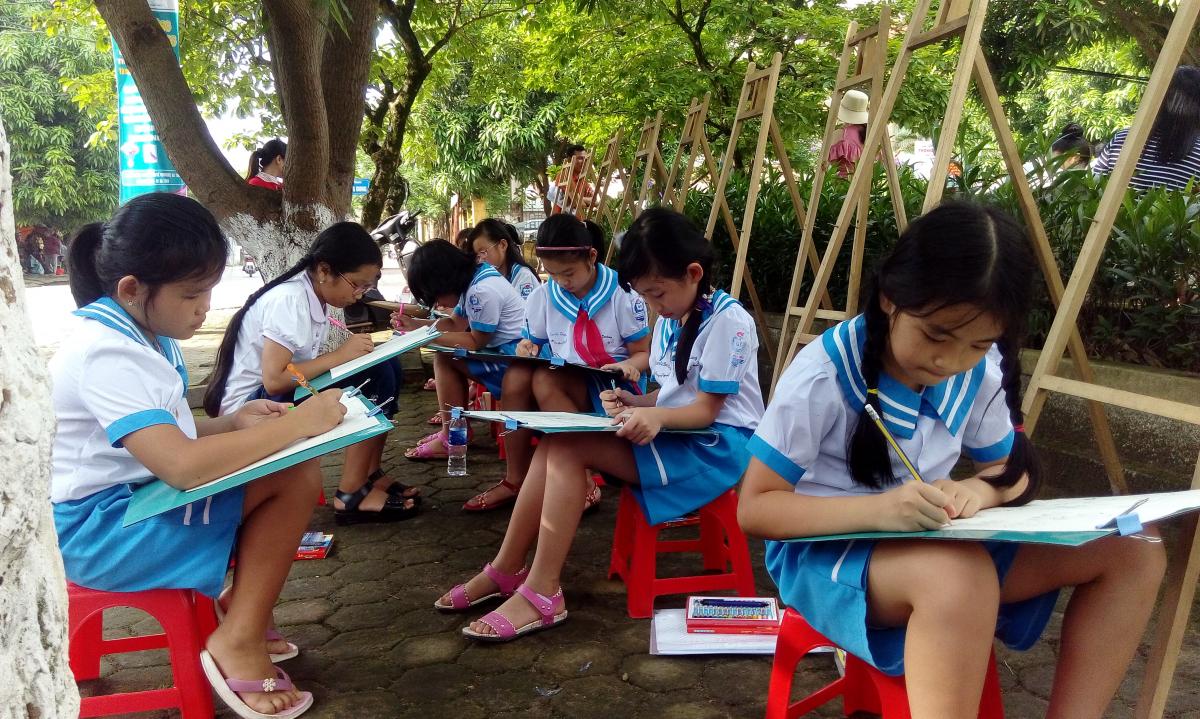
Students in Ha Tinh city joined drawing contest: “Ha Tinh –My city”
Huong TRANTHANH | 10/07/2017
On 21 May 2017, The Project Coordination Unit of SRDP-IWMC Ha Tinh collaborated with the Bureau of Education &Training (BOET) and The Youth Union of Ha Tinh city organized a drawing contest named “Ha Tinh – My city”. The contest attracted more than 500 students from primary and secondary schools in Ha Tinh city, covering multiple topics such as “Green homes, green schools”, “Water saving”, “Ha Tinh city in the future”, and "Climate change effects resilience" Completed paintings were exhibited at Ly Tu Trong park right in the city center, attracting thousands of parents, students and local residents. The event hope to raise the awareness among the children on Climate changes and how to contribute to a modern and green city.
-
My HIV status does not impact my future
Josephine OMUNYIDDE | 04/07/2017
“My name is Avayo Denis. I am 19 years old and I am HIV positive. I have been living positively since 2012 and am now on ARV treatment. My family and I came from South Sudan in 2016 as a result of the crisis.” Denis’s classmates at the catering class in the Skills Training Center of Welthunger Hilfe in Rhino Camp in Northern Ugandan district of Arua refer to him as “Manager Denis” because he aspires to become a manager of a hotel one day. One striking thing about Denis is that he does not try to hide his HIV status and has written on the right side of his pocket shirt – “HIV++++”. He says: “Life for me has just started. My health status does not impact my future, because these catering skills I am learning will make me self-reliant in society while fighting stigma among youth living with HIV/AIDS”. In recognition of the vulnerable persons such as Denis, the Support Programme for Refugee Settlements and Host Communities in Northern Uganda (SPRS-NU) funded by European Union Emergency Trust Fund (EUTF) addresses cross cutting issues in its programmes supporting the refugee and host communities in Northern Uganda. As such, BTC Uganda is operating a Skills Development Fund that is specifically targeting vulnerable youth to acquire skills relevant for the labour market and is working with training centers in the settlements to mainstream gender and HIV awareness in the curricula.
-
‘Unfortunately a lot of diseases are still poverty related’
Thea MATHUES | 29/06/2017
Doctor Daniel Okello has worked for Angal Hospital, in the Northern region of Uganda, for over 6 years. The hospital is situated in a poor and rural area and faces, like many health facilities in the region, a lack of means and under-staffing. Still doctor Okello carries on: "In this hospital we look out for each other, the job satisfaction makes it worth to push through the hard times." I’ve been with this hospital for 6 years now. I came here fresh from school because, they urgently needed medical officers. In the beginning I had a hard time adjusting. The place is remote compared to Gulu, the city I’m from, but as soon as you adjust your mind-set, you can handle it. Most people in this area are living in poverty. Therefore a lot of diseases are poverty related and could be easily avoided, if not for the lack of recourses people face. You see this for example in perforations of intestines due to bad food patterns when people eat roots or bad herbs. A lot could be prevented given the correct health education. This could truly make a difference. I try to take the time to teach my patients, teach mothers about basic healthcare for their children. But this takes a lot of time and as a doctor you are often the only one in a ward. Taking 20 to 30 minutes per patient to talk things through isn’t always possible and takes a lot of effort. Student lifeIn 2009 I finished my training through an internship in Gulu hospital and went straight to Angal. When you are a medical student it is all about the books and the exams. Doing my internship in a town setting also made it easy. It got me thinking: ‘this doctor thing is rather easy’. But there is much more you need to take into account. I realized the climate, the culture of the people, the working conditions can vary a lot. Overall I think it is important to understand as a trainee that what you learn in class is less than 20% of what you do on the ground.As a kid I admired doctors. I wanted to become like them, even though I didn’t really understand what they were doing. So when I got older I informed myself on the profession and decided I wanted to go ahead with my childhood dream. I have never regretted it. Result-based financingI like the quality aspect that comes with introducing result-based financing. Before we didn’t always take blood pressure of every patient, we didn’t do a full lab test. Instead we mainly treated patients based on a doctors clinical assessment. Now we fully investigate. This has made a big difference. We now know in advance if people are fit for operation. We spend more time with each patient and have more drugs than before to treat people. We are happy with the support from BTC but I think we could still benefit from more regular visits of the project team. Result-Based Financing is not an easy system to implement. It really takes a complete mentality shift. Therefore it is good to have close contact with each other. ChallengesOne big challenge remains the lack of qualified staff. We are understaffed and under paid. With more patients coming in due to lower fees, it creates more fatigue with staff. We are in need of specialized medical doctors and not just generalists. If possible I would love to go back in for training. Some of our wards are too small. We currently have about 70 beds in the children’s ward, but during busy times almost 200 children stay there. They sleep on the floor to save space. In future, this needs to change.Working togetherWhat I like about Angal hospital is that regarding of the circumstances we really work together as a team. We look out for each other. Besides this, the job satisfaction makes it worth to push through the hard times. As a final remark I want to say that our lab has recently really improved, which has made our work easier and made us deliver higher quality care.
-
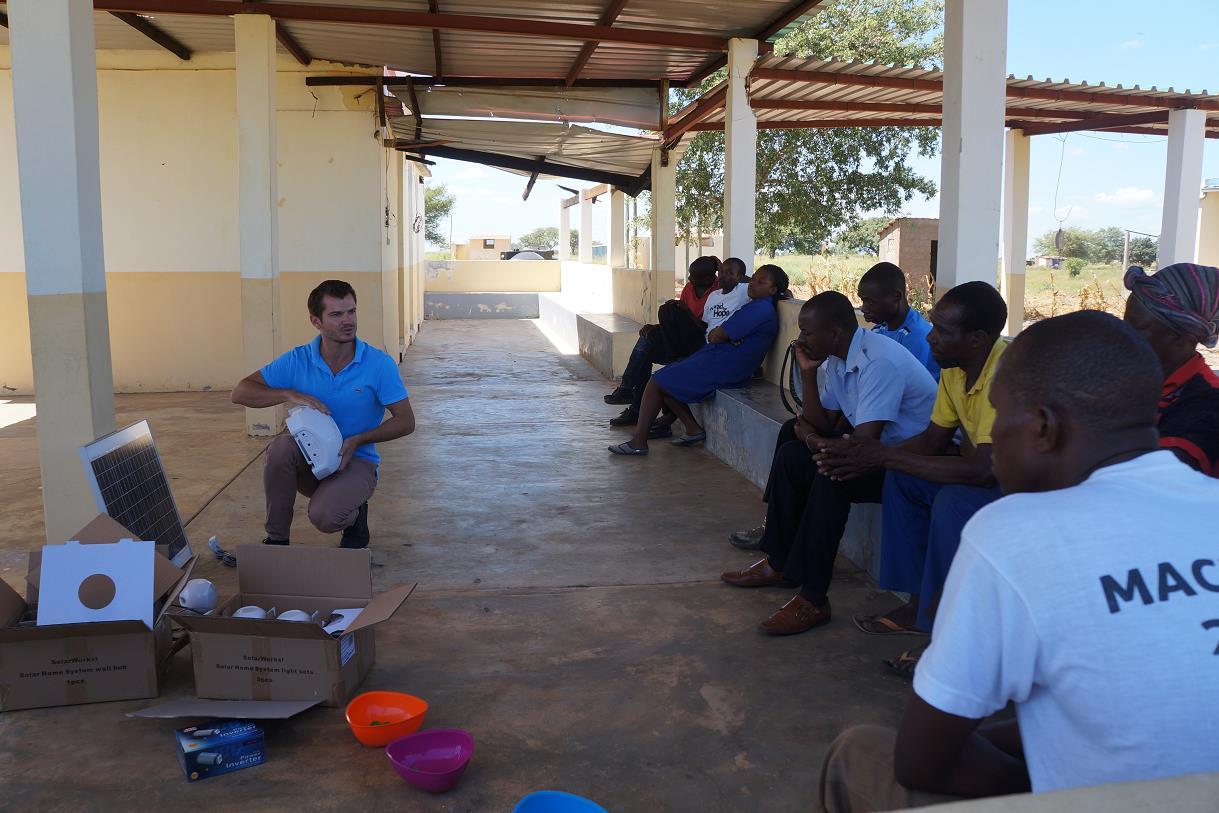
Focus Group in Porto Henrique
Stephan CLAES | 28/06/2017
To improve and promote access to modern and renewable energy in Mozambique, BTC cooperates closely with the Mozambican national energy institution (Fundo de Energia - FUNAE) since 2010. In this light, the RERD project (Renewable Energy for Rural Development) was created, focusing on access to energy in rural areas. For this project, a team of international experts conducted a market study to find renewable energy solutions for off-grid communities in rural Mozambique. The study also looked into the potential role FUNAE could play in promoting private sector engagement in the renewable energy market. According to the study, one option lies in creating favourable conditions to privatize renewable energy solutions in off-grid communities, including the sale and maintenance of small solar systems for households and small businesses. The use of these solar systems typically leads to electricity solutions that are safer, lower cost, and cleaner than the alternatives currently used by the rural communities. In this light, BTC, FUNAE, and its team of consultants conducted a feasibility study in the village of Porto Henrique to assess how much money local residents spend each month on electricity, and what they use it for. Results from the initial questionnaire, which was conducted in February 2017, led to the organisation of a focus group to find out more about the local population’s habits and expectations in terms of electricity use. On 23 March 2017, the focus group assembled a small number of people from different families representing the overall population of the village. The discussions held revealed that most of them currently rely on battery powered torches or gasoline lamps to light up their house at night, and that they charge their phones in the local shop for a small fee with electricity generated by a generator. Light and the charging of cell phones were the primary uses of electricity, and residents of the village spend around 350 Meticais per month on the electricity for these uses. This information was very useful, and helped finalize the market study for potential private investors in the recent weeks. Additionally, in order to find out whether or not local residents would be interested in purchasing a home solar system (to be paid off with a monthly payment plan for 3 years), BTC and its team of consultants demonstrated an easy to install and user friendly home solar system of 50 watts. This device would enable the local population to illuminate their house with three bright LED lights, charge phones, and listen to the radio or watch TV. For those that want a more powerful installation, for example to also run a fridge or freezer, larger solar installations that produce more electricity are available. The solar devices are provided by the Solarworks company, one of the private actor implementers of the pilot projects. The first impression BTC and the consultants received from the focus group was positive: they were very interested in the different solutions offered, and indicated the willingness to invest in home solar systems. Therefore, BTC and its partners look forward to further implement the pilot projects to provide local populations in rural Mozambique with green energy solutions.
-

Rebuilding lives for South Sudanese refugees in Northern Uganda: EUTF SPRS-NU Video
Josephine OMUNYIDDE | 28/06/2017
10 months after fresh violence erupted in South Sudan, a famine produced by the vicious combination of fighting and drought is now driving the world’s fastest growing refugee crisis. Uganda currently hosts more than 900,000 South Sudanese refugees. Among them are some 600,000 new arrivals who have poured into Uganda since July 2016. And thousands continue to arrive daily. With present rates, that figure will surpass a million before mid - 2017.86 % are women and children. Uganda has one of the most progressive and exemplary refugee policies in the world. Upon receiving refugee status, the policy provides that refugees are provided with small areas of land in villages integrated within the local host community; a pioneering approach that enhances social cohesion and allows both refugees and host communities to live together peacefully. However, even the most welcoming policy has its limits. The unprecedented mass influx is increasingly placing enormous strain on public services, local infrastructure and environment. Land allocations are limited. Humanitarian response faces chronic and severe under-funding. Lack of livelihood activities and education, sustainable water supply and environmental degradation are among the biggest development challenges. Under the EU Emergency Trust Fund (EUTF), The Support Programme for Host Communities in the Northern Uganda (SPRS-NU) has been established in 2016. The overall objective of the action is to reduce the risk of violent conflict between host communities and refugees in the refugee-hosting districts of Northern Uganda, namely Adjumani, Arua, Kiryandongo and Yumbe. This project, implemented by Belgian Technical Cooperation (BTC), Austrian Development Agency (ADA) and NGO Consortium (led by the Danish Refugee Council), addresses the developmental needs of South Sudanese refugees and host communities in Northern Uganda. This is done through support to improving their living conditions by enhancing food security, inter community dialogue and conflict prevention, and provision of basic services such as education, water and sanitation. This video shows both the situation in the Northern Uganda and how the €20 million SPRS programme in Northern Uganda, channeled through the EU Trust Fund for Africa, helps South Sudanese refugees and host communities.
-

WORK BASED LEARNING
William YEKA | 28/06/2017
Uganda's renown private sector players discuss their readiness to support work based learning. Work based learning is an educational strategy that provides trainees with real-life work experiences where they can apply academic and technical skills and develop employability skills.
-
Only girl, graduated on top of her skills training class
Josephine OMUNYIDDE | 28/06/2017
22-year old Viko Gloria graduated on top of her class in January 2017 from the Skills Training Centre of Welthunger Hilfe. She is now a co-instructor for the Carpentry and Joinery class at the center in Rhino Settlement in Arua District, Northern Uganda. “My performance was good and that is why I was retained to teach. I am already earning a salary and I also plan to make furniture such as beds and roofing material for sale to earn extra income during my free time” says Gloria. With this additional savings income, Gloria will be able to take care of her parents and educate her younger siblings. Gloria was among the youth attaining livelihood and labor market relevant quality skills to create jobs and improve their standards of living. Gloria was the only girl in her class. Moreover, the class that she teaches currently has no female student neither, nevertheless with her recent promotion she plays a role model among fellow young girls. She is one of the few nationals from the host community at the center. The Ugandan Government programme ‘REHOPE‘ focuses on integrating both refugees and host communities in its programme ensuring co-existence. BTC-Uganda promotes skills development as part of the Support Programme for Refugees Settlements and Host Communities in Northern Uganda (SPRS-NU) funded by European Union Emergency Trust Fund (EUTF). It is supporting improved training programmes such the one Gloria graduated from. By working with national Ministry of Education and Sports BTC Uganda aims to ensure quality, standardization and certification of skills training for refugees and host communities.
-
Les forgerons de Gemena, de nouveau des hommes debout !
Julie CLAASSENS | 28/06/2017
Les artisans forgerons jouent un rôle très important dans l’économie locale de Gemena. Ils adaptent des vélos pour le transport de lourdes charges, ils produisent de petits outillages domestiques et ruraux, ils construisent de réchauds améliorés qui limitent la consommation de bois, ainsi de suite. Malheureusement ces forgerons sont très démunis et ne possèdent pas, pour la plupart, d’outils performants et d’équipements de sécurité. Ils travaillent généralement assis et avec des méthodes peu ergonomiques et très fatigantes. En plus, il n’y a pas d’école de forge à Gemena. Pour faire face à ces problèmes et afin d’appuyer le secteur privé, la CTB soutient les forgerons à travers un subside, qui permet leur accompagnement quotidien et un appui à leur structuration. C’est dans ce cadre qu’un forgeron bruxellois de la société Feu et Fer, spécialisé dans l’organisation de stages et de formations de forge, est venu à Gemena début juin pour donner une première formation de dix jours. Cette formation avait pour objectif de former les forgerons qui deviendraient ensuite formateurs et elle comprenait dans son programme des aspects techniques mais aussi pédagogiques. Les échanges se faisaient entre professionnels sur base de leurs savoirs réciproques. D’abord, une grande attention a été accordée aux questions ergonomiques -c’est-à-dire faire des gestes respectueux du corps- et aux questions de sécurité. Il s’agissait d’enseigner des pratiques correctes, dont un point très important était de passer d’une stature de travail assise à debout en plaçant les enclumes sur un billot de bois et en utilisant un foyer de forge à même hauteur que l’enclume.En plus de l’utilisation des enclumes le maître forgeron a montré d’autres outils, comme les pinces. D’ailleurs, la formation a permis de montrer aux forgerons qu’ils pouvaient fabriquer eux-mêmes la plupart des outils dont ils avaient besoin. Par exemple, les forgerons ont fabriqué une plane afin de pouvoir finaliser la fabrication de manches pour leurs marteaux. Cet outil, la plane, était inconnu à Gemena. Enfin, ils ont également appris à travailler le fer en le portant à la bonne température. La formation a sans doute servi de révélateur de toutes leurs possibilités. A la fin des dix jours, le forgeron Alfred témoignait : « Moi, je n’ai pas la chance d’avoir une vraie enclume. J’utilise un vieux bloc moteur. Mais maintenant, je vais placer mon bloc moteur en hauteur, sur un billot de bois. Je ne veux plus travailler assis ».La cerise sur le gâteau était l’importation à Gemena d’une dizaine d’enclumes et d’autres outillages, ainsi que d’équipements de sécurité. Il s’agit maintenant de réfléchir avec l’association des forgerons aux manières d’utiliser tout d’une manière durable.
-
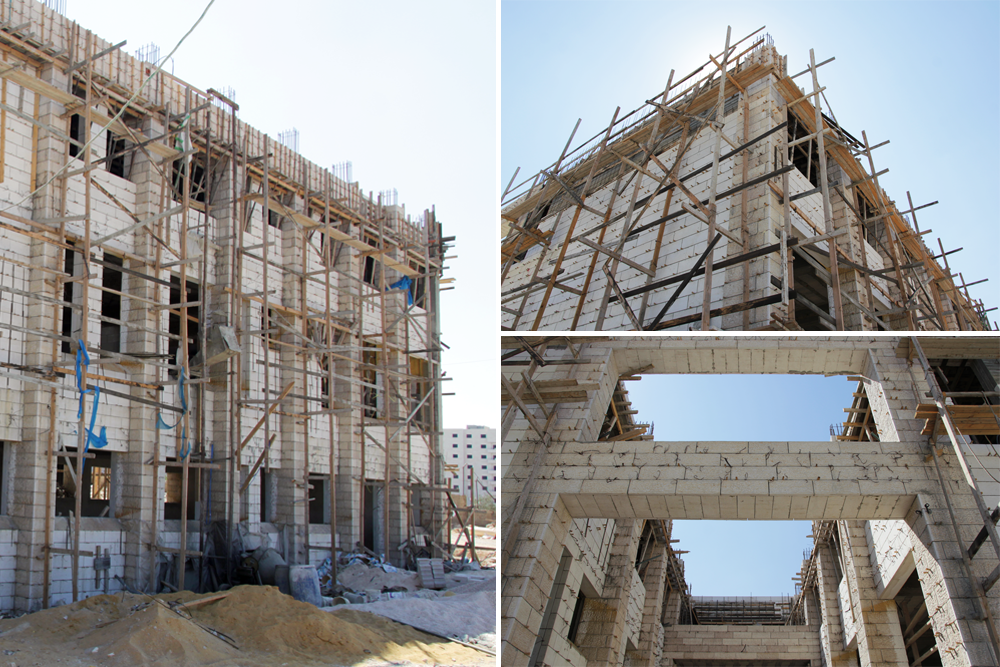
Work in progress: A new building for the Hebron Industrial Secondary School
Laura SCHILLEMANS | 28/06/2017
A few snapshots from our visit to the new facilities of the Hebron Industrial Secondary School. The new building will be ready in October and it will host seven TVET specializations, of which the first three are new for the school: Central heating / plumbing / AC (installation)Metal workshopAC (repair) + refrigerationComputer workshopElectronic workshopElevator technologyBuilding management systemWe already look forward to the inauguration!
-
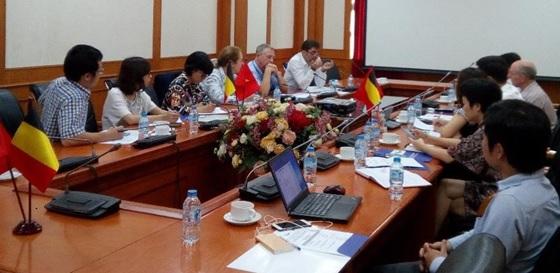
BIPP PASS MIDTERM REVIEW
Huong TRANTHANH | 28/06/2017
On June 23rd, 2017 the BIPP MTR was completed with the restitution workshop where the MTR consultant presented their findings and recommendations. The workshop was attended by senior representatives of MoST, BTC Resident Representative as well as some key project stakeholders. The Development Cooperation Counselor of the Belgian Embassy presented as well. The MTR consultant delivered a concise presentation on BIPP overall implementation performance since project inception. In conclusion, despite BIPP’s difficult start-up phase, the project is on course to meet most of its objectives. BIPP is highly aligned to national strategies and policies of the Government of Vietnam and MoST for private sector development. More concretely, the project has made important achievements in determining best practices and lessons learnt to support incubator policy development, piloting of a grant seed fund and two TBIs with 38 tenants. The main challenges rest with management for results. There is insufficient evidence at this stage to conclude that the observed dynamic of the intervention and the piloting of Innofund and one TBI are sustainable. However, discussions with the stakeholders suggest that they can be successfully addressed. In addition, the MTR consultant highlighted few important recommendations for BIPP to consider centering on: Activation of the inter-ministerial and inter-agency cooperation to strengthen the network and communication of the valuable policy support tools developed by BIPP to a much wider public and private sector audience; Complementing the existing M&E system by additional impact assessments and surveys of final beneficiaries. This should help to assess more precisely impact, cost effectiveness and lessons learned from the project; Increase of the likelihood of sustainability of the supported Technology Business Incubators and development of a realistic survival strategy for them; BIPP will closely look into the MTR recommendations and will instigate appropriate implementation actions respectively.
-

The role of the private sector in skills development
Hanna DEKERK | 28/06/2017
How can an increased involvement of the private sector improve business, technical and vocational education and training (BTVET) in Uganda? Some key private sector actors share their views.
